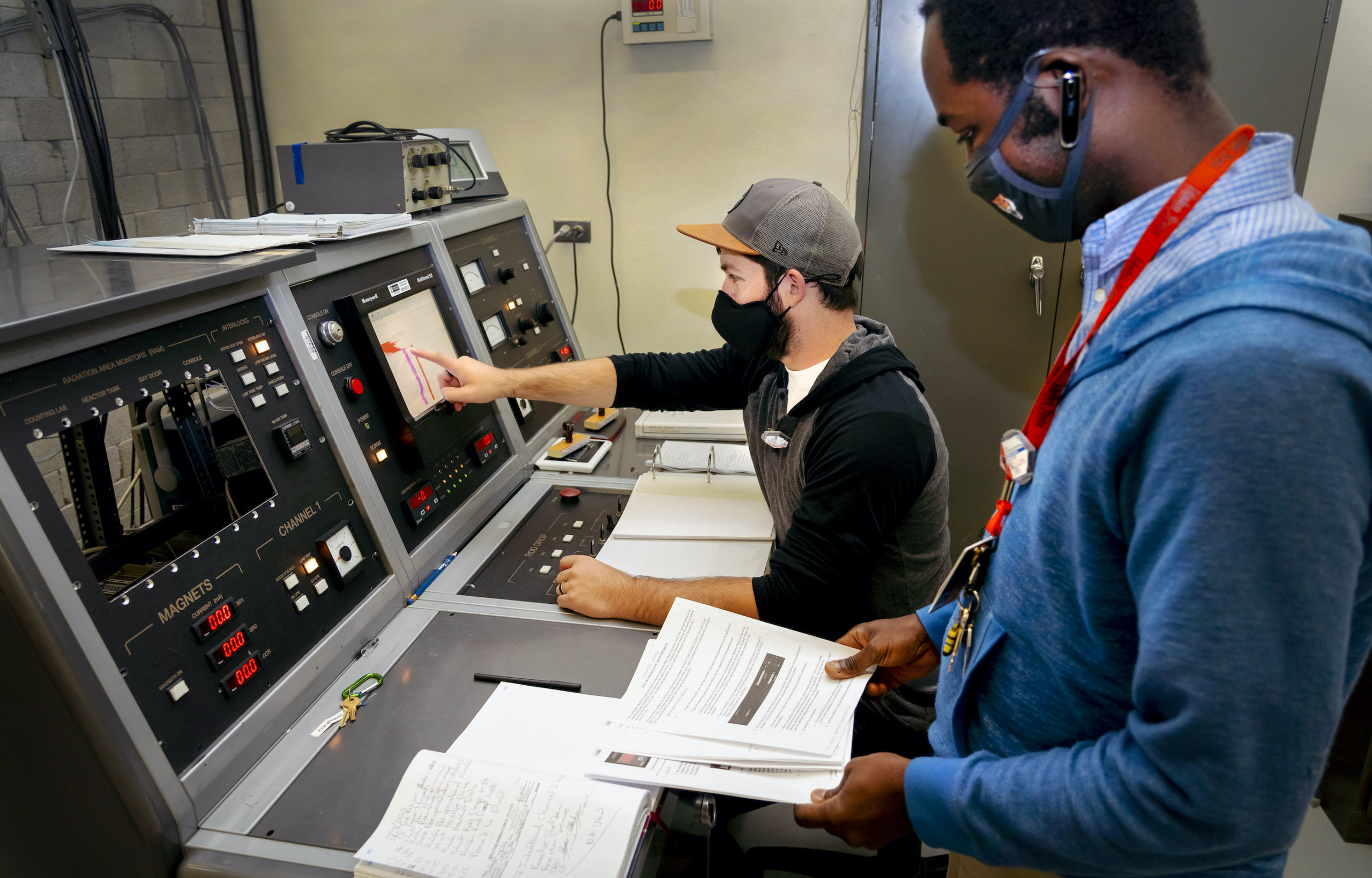A ribbon-cutting and dedication ceremony for the new operating console for Idaho State University’s research and training nuclear reactor was held on Oct. 20 as part of Nuclear Science Week activities at the University. The event was closed to the public because of the pandemic, but video of the ceremony has been posted and available on the Idaho State YouTube channel, and a virtual tour of the reactor facility will be available online at isu.edu/NE.
By upgrading to the new console, we now have a reactor on campus that is fundamentally good to go for another 50 years, said Chad Pope, Department of Nuclear Engineering chair and professor. By getting this upgrade in place it really makes the ISU nuclear engineering program here for the long haul. The INL is not going anywhere and we are not going anywhere. We are built for the long term.
Idaho State has been home to an Aerojet-General Nucleonics nuclear reactor, commonly known as AGN-201, since it was donated by the Idaho National Laboratory in 1965. AGN-201 is a low-power, 5 watts, reactor that is commonly used for both academic and industrial research/experiments, as well as for various testing and training purposes. It is located in the Nuclear Science Laboratory on the lower level of the Lillibridge Engineering Building.
Replacing the console was an approximately 15-year process that couldn’t have been completed without the dedication of Jay Kunze, ISU professor emeritus of nuclear engineering and former dean. Kunze is being honored at the event for his work on the reactor console and his overall dedication and service to the university. The new console, built and designed at ISU, will have a plaque on it recognizing him.
 Jay Kunze has really been the driving force behind getting this project to completion, said Mary Lou Dunzik-Gougar, associate dean of the College of Science and Engineering and Center for Advanced Energy Studies (CAES), associate nuclear engineering professor and current reactor administrator who has led the CAES effort to establish a joint certificate in Nuclear Safeguards & Security. It takes time and persistence to get this type of project completed and that is what he provided. He just kept it going, found students and faculty to get involved and engineering professionals to volunteer their help. He just never gave up. This is an example of the many things he has done to support the university, the college and, specifically, the nuclear program over the years.
Jay Kunze has really been the driving force behind getting this project to completion, said Mary Lou Dunzik-Gougar, associate dean of the College of Science and Engineering and Center for Advanced Energy Studies (CAES), associate nuclear engineering professor and current reactor administrator who has led the CAES effort to establish a joint certificate in Nuclear Safeguards & Security. It takes time and persistence to get this type of project completed and that is what he provided. He just kept it going, found students and faculty to get involved and engineering professionals to volunteer their help. He just never gave up. This is an example of the many things he has done to support the university, the college and, specifically, the nuclear program over the years.
Pope noted the upgrade to the console was the work of many individuals over a very lengthy period of time and credited all who worked on it.
A lot of skilled and talented people participated, but it was really the determination of Jay Kunze that saw it to completion, Pope said. It is just that simple, and that is why it is so important to recognize his leadership in seeing this task to completion and the significance it has for the ISU nuclear engineering program going forward for decades to come.
During Nuclear Science Week, running Oct. 18-24, the Department of Nuclear Engineering is also recognizing Dunzik-Gougar, who is serving as national American Nuclear Society president. In addition, ISU is honoring the late professor and department chair Michael Lineberry, who also had a 38-year career at Argonne National Laboratory as a senior nuclear engineer and division director. He died in 2014 at the age of 67.
He was our department chair in nuclear engineering but was a long-time proponent and supporter of education before coming to academia, Dunzik-Gougar said. He retired from Argonne National Lab and came full time to the university. He really helped build the foundation for the department that exists today so we want to honor him posthumously.
Idaho State University’s AGN-201 Nuclear Reactor Fact Sheet
- For more than 50 years the College of Science and Engineering at Idaho State University has been home to an Aerojet-General Nucleonics nuclear reactor.
- Commonly known as the AGN-201, this reactor is one of five that are still operating in the world, and was donated to ISU by the Idaho National Laboratory in 1965. This low-power reactor is commonly used for both academic and industrial research/experiments, as well as for various testing and training purposes.
- The AGN-201 reactor has a maximum operating power of 5 watts thermal, and is not used for the generation of electricity. Generally, licensed students from Idaho State operate the reactor after completion of a rigorous training course and passing a United States Nuclear Regulatory Commission exam. Having this valuable resource on campus provides students with a unique opportunity to gain hands-on experience operating and working on a functional nuclear reactor, and enhances the overall research capabilities here at the university.
- The ISU AGN-201 reactor’s principal purpose is to educate students through operations and experimentation on the safe operation of a nuclear reactor, the theory of radiation, radiation safety, fission and other pertinent topics. Thus, the students are able to learn hands on and obtain a unique educational experience.
- More than 40 of these reactors were in use, however only five remain in the world today. Three of these five remain in operation in the United States. The reactor was originally kept in the first engineering building and then in 1969 it was moved to the Lillibridge Engineering (LEL) Building. The reactor had to be lowered into the LEL building by a crane due to its size. The reactor was only approved to generate 0.5 Watts of thermal energy (heat) when first operated here at ISU. After proving the safety of the reactor, an upgrade to generate 5 Watts of thermal energy was approved.
- This reactor is safe. It puts out a very small amount of heat, 5 watts, that doesn’t require cooling and has appropriate shielding. The core of the reactor, about the size of a five-gallon bucket, is surrounded by graphite that helps reflect neutrons back into it and the graphite also acts as a shield. This shield is surrounded by a tank of water, that is surrounded by bricks that have barium in them that are especially made for this purpose. All these layers provide shielding so the amount of radiation that can get out is exceptionally minimal and the amount of radiation emitted, which is usually zero, is continually monitored.






